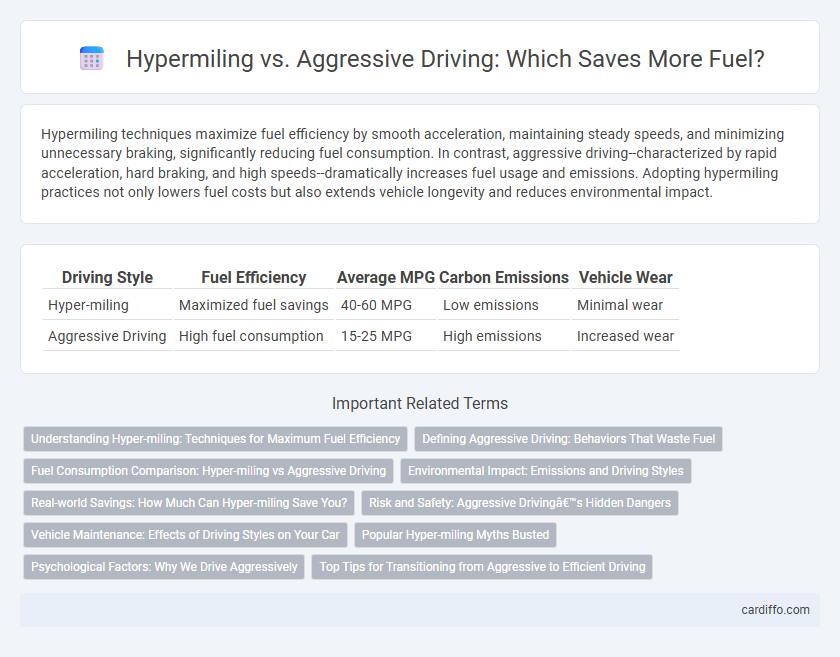Hypermiling techniques maximize fuel efficiency by smooth acceleration, maintaining steady speeds, and minimizing unnecessary braking, significantly reducing fuel consumption. In contrast, aggressive driving--characterized by rapid acceleration, hard braking, and high speeds--dramatically increases fuel usage and emissions. Adopting hypermiling practices not only lowers fuel costs but also extends vehicle longevity and reduces environmental impact.
Table of Comparison
| Driving Style | Fuel Efficiency | Average MPG | Carbon Emissions | Vehicle Wear |
|---|---|---|---|---|
| Hyper-miling | Maximized fuel savings | 40-60 MPG | Low emissions | Minimal wear |
| Aggressive Driving | High fuel consumption | 15-25 MPG | High emissions | Increased wear |
Understanding Hyper-miling: Techniques for Maximum Fuel Efficiency
Hyper-miling employs techniques such as smooth acceleration, maintaining steady speeds, anticipating traffic flow, and minimizing idling to maximize fuel efficiency. Utilizing features like cruise control and reducing aerodynamic drag also contribute significantly to lower fuel consumption. Implementing these methods can lead to fuel savings of up to 20-30% compared to aggressive driving habits.
Defining Aggressive Driving: Behaviors That Waste Fuel
Aggressive driving includes rapid acceleration, frequent hard braking, and speeding, all of which significantly increase fuel consumption by forcing the engine to work harder. These behaviors can reduce fuel efficiency by up to 33% on highways and 5% in city driving according to the U.S. Department of Energy. Avoiding aggressive driving not only conserves fuel but also lowers emissions and reduces vehicle wear.
Fuel Consumption Comparison: Hyper-miling vs Aggressive Driving
Hypermiling techniques, such as smooth acceleration and maintaining steady speeds, significantly reduce fuel consumption by optimizing engine efficiency and minimizing unnecessary braking. In contrast, aggressive driving behaviors like rapid acceleration, harsh braking, and speeding can increase fuel consumption by up to 40% due to inefficient fuel use and higher engine load. Studies indicate that adopting hypermiling can improve fuel economy by 15-30%, making it a more cost-effective and environmentally friendly driving strategy compared to aggressive driving.
Environmental Impact: Emissions and Driving Styles
Hypermiling techniques significantly reduce fuel consumption and lower carbon dioxide emissions by promoting steady speeds and minimizing acceleration, directly decreasing environmental pollution. Aggressive driving, characterized by rapid acceleration, hard braking, and speeding, increases fuel consumption and elevates emissions of nitrogen oxides, carbon monoxide, and particulate matter, contributing to air quality degradation and climate change. Studies show that adopting fuel-efficient driving styles can reduce greenhouse gas emissions by up to 30%, supporting sustainable transportation goals.
Real-world Savings: How Much Can Hyper-miling Save You?
Hyper-miling techniques can improve fuel efficiency by up to 30%, translating to significant cost savings over time, especially for drivers covering long distances. Aggressive driving, characterized by rapid acceleration and hard braking, can decrease fuel economy by 15-30%, leading to higher fuel expenses and increased emissions. Real-world studies show that adopting hyper-miling habits can save hundreds of dollars annually on fuel, making it a practical strategy for budget-conscious drivers.
Risk and Safety: Aggressive Driving’s Hidden Dangers
Aggressive driving significantly increases the risk of accidents due to higher speeds, abrupt lane changes, and reduced reaction times, leading to severe injuries or fatalities. Hyper-miling, by contrast, promotes smooth acceleration, steady speeds, and anticipatory driving, enhancing vehicle control and safety margins. Choosing hyper-miling techniques reduces the likelihood of collisions and improves overall road safety while maximizing fuel efficiency.
Vehicle Maintenance: Effects of Driving Styles on Your Car
Hyper-miling improves fuel efficiency by promoting smooth acceleration and braking, which reduces engine strain and extends the lifespan of critical components like brakes and tires. Aggressive driving, characterized by rapid acceleration and hard braking, increases wear and tear on the engine, transmission, and brake system, leading to more frequent repairs and higher maintenance costs. Maintaining an optimal driving style directly impacts vehicle longevity and reduces overall fuel consumption through enhanced mechanical efficiency.
Popular Hyper-miling Myths Busted
Popular hyper-miling myths such as coasting in neutral or turning off the engine at red lights can actually reduce fuel efficiency and risk safety. Techniques like maintaining steady speeds, using cruise control, and anticipating traffic flow are proven to optimize fuel consumption effectively. Aggressive driving, including rapid acceleration and hard braking, can increase fuel use by up to 30%, debunking myths that aggressive maneuvers improve mileage.
Psychological Factors: Why We Drive Aggressively
Aggressive driving often stems from psychological factors such as stress, impatience, and the perceived need for control, which can lead to increased fuel consumption and reduced mileage compared to hypermiling techniques. Hyper-milers adopt calm, deliberate driving behaviors that optimize fuel efficiency by minimizing sudden acceleration and braking. Understanding these psychological triggers can help drivers shift toward fuel-saving habits and lower overall environmental impact.
Top Tips for Transitioning from Aggressive to Efficient Driving
Shift smoothly and accelerate gradually to reduce fuel consumption by up to 20%, cutting aggressive-driving fuel waste significantly. Maintain steady speeds using cruise control on highways and anticipate stops to avoid rapid braking, enhancing mileage efficiency. Regularly check tire pressure and engine performance to support optimal fuel economy during the transition to hypermiling techniques.
Hyper-miling vs Aggressive Driving Infographic

 cardiffo.com
cardiffo.com